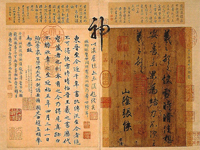THREE TESTS OF AUTHENTICITY
-Determine Authenticity
1. The morphological features of the style of a work. This test helps establish a probable earliest date for the appearance of the morphological features themselves. It includes clarifying the historical relationship of his style to that of contemporaries, prerecession sources and followers, whether it lacks motifs and form relationship or not.
2. The artistic Quality: This test aids in establishing the latest date of creation. It focuses on the execution of a work’s pictorial features, primarily the psychic vitality or energy levels of the brushwork. It keeps the appraiser vigilant for possible discrepancies among individual hands, in a close copy of an original or historically correct design and tends to function on the 3rd level of stylistic definitions, such as “expression.”
3. Basic Physical Properties: The test focuses on the physical aspects of a painting (paper, silk, ink, color, seal paste, seal) via scientific verifications. A correct reading of inscriptions or verification of seals are invaluable in determining a rough date of execution.

